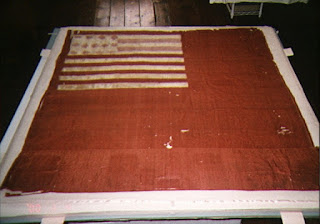Happy Independence Day!
The year is 1777,
fourteen months have past since the Declaration of Independence was signed and
the colonists fight for their freedom in America’s first great war. The British have set out to
capture Philadelphia. Washington’s best defense against General Howe and the
advancing British army lies at Brandywine Creek, approximately 25 miles
southwest of the city. Washington has strategically positioned his troops at
vital crossings along the creek, choosing high ground at Chadd's Ford as his
primary defensive position.
On September 11, General Howe pretended to launch an attack at Chadd's Ford, but in fact, the majority of his army had crossed the Brandywine farther north, surprising the Americans with an attack to their right flank. Howe's strategy works and Washington orders a retreat, but the Continental Army remains intact. The British take Philadelphia, but the rest, they say, is history.
The Brandywine Flag,
reportedly flown during this historic battle, was a banner carried by Captain
Robert Wilson's company of the 7th Pennsylvania Regiment. The company flag received the name after it was used
in the Battle of Brandywine. The
flag is red, with a red and white American flag image in the canton.
 |
| Brandywine Flag |
 |
| Washington's coat-of-arms |
As any good
vexillologist will tell you, the 7th Pennsylvania Flag may have been one of the
first American flags to feature stars and stripes. It has been referred to as a flag within a flag or a canton within a canton. Specifically, the flag shown in the canton
of the Brandywine Flag uses a 4-5-4 star pattern. As it is composed only of red and white, perhaps this was to reflect Washington's own coat of arms?
 |
| Close up of Brandywine canton |
About 13 years ago, Spicer Art Conservation had the
opportunity to perform the textile conservation of this very flag, and what an honor it was. There is really something magical about
an artifact that comes from a time period that defined the beginnings of what
was to become the United States of America. Flags of this era (and other wartime flags) are nearly
always hand-sewn. They exude
pride. These flags were made by
wives and mothers who were sending their men into battle. The men carrying them were not expected
to come back, however the hope of their return was undying.
The flag survives today and is housed at Independence Hall
in Philadelphia, where it will likely never be displayed again. Why? Light damage.
For 30+ years the Brandywine flag sat sandwiched in a display case with
fluorescent lights imbedded into the frame. These lights blasted the flag from two sides, in what is referred to as "raking light damage". Imagine that the flag is not just being exposed to light from the front, but the light is intentionally directed to its surface horizontally from both the left and right. This type of damage effectively
cooked the Brandywine Flag to an irreparable state. Light of this nature does not just fade colors, it chemically changes the material itself. In this case, the Brandywine Flag is made of a plain balanced silk. It is not terribly thick and the weave is not super tight, and silk, when exposed to unrelenting light, goes from being supple to becoming still flexible, but if touched, turns to a fine powder. And so, while this piece of history lives on, it must survive in storage.
Treatment of this flag was a slow and delicate process. The flag had been encapsulated between two layers of silk and was mounted on wool (can you say bug infestation?) with a fine filament line. The wool and silk would have been a perfect feeding ground for a variety of insects, however, while the display box and its constant light caused damage, possibly it was this very box that kept the bugs at bay and saved the flag from being eaten by insects.
This begs the question: Did the curators and conservators of thirty years past think
they were doing anything that was damaging to this artifact? Certainly not. But in hindsight, they chose to display
this flag in a way that was profoundly destructive. Looking back through the history of textile conservation and the
various methods in which textiles have been displayed, one can not help but wonder
if the methods we are using now will be considered detrimental in the decades
that follow?
_____________________________
Gwen Spicer is a textile conservator in private practice. Spicer Art Conservation specializes in textile conservation, object conservation, and the conservation of works on paper. Gwen's innovative treatment and mounting of flags and textiles is unrivaled. To contact her, please visit her website.
Gwen Spicer is a textile conservator in private practice. Spicer Art Conservation specializes in textile conservation, object conservation, and the conservation of works on paper. Gwen's innovative treatment and mounting of flags and textiles is unrivaled. To contact her, please visit her website.

No comments:
Post a Comment